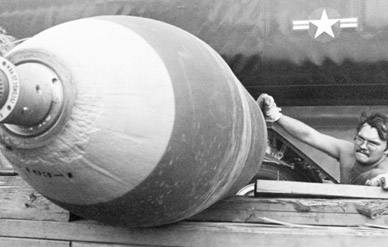North Vietnam 1965-72

Bomb being prepared for Linebacker II
When Nixon became president, the air wars continued as they had at the end of 1968. This meant that outside of North Vietnam, bombing kept on as it had under Johnson: tactical and map grid strikes in South Vietnam, as well as anti-infiltration bombing in Laos. However, the ending of Rolling Thunder (see chapter six of the book for the operation and chapter five for a discussion of negotiations) was a recent U.S. diplomatic and political commitment which could not simply be discarded. Nixon, frustrated at this “very, very great mistake” and understanding that he “could no longer play [the bombing chip] unless given sufficient provocation,” therefore had to rely on other sorts of bombing to coerce North Vietnam into agreeing to withdraw its forces from South Vietnam. One way, as we discussed elsewhere on this website, was by a series of secret strikes against North Vietnamese installations in Cambodia; another was by brief retaliatory attacks when reconnaissance aircraft were supposedly fired on. These latter were so strongly criticized that the point was once again driven home: only North Vietnamese actions considered as egregious could serve as justification for the resumption of overt bombing. That day arrived in the spring of 1972, when the North Vietnamese launched a large-scale conventional offensive in South Vietnam's northern provinces. The U.S., claiming that this was an “invasion of South Vietnam” and a “flagrant violation” of the 1968 bombing halt agreement, resumed bombing of North Vietnam and then, when the offensive continued and Hanoi did not agree to U.S. demands, escalated further the bombing and mined the country's principal port. Ironically, these actions were no longer justified as helpful in bringing about North Vietnamese withdrawal from South Vietnam – the U.S. had, under domestic political pressure, dropped that demand in 1971 and asked only that “the Vietnamese ... discuss [it] among themselves” – but as a means simply of forcing a “return to the situation” prior to the spring offensive and of inducing later, more political, concessions.
Some months later, as the negotiations were reaching their final stages, the rationale shifted again. In October, the bombing was partly suspended to facilitate a peace agreement. However, the Saigon regime was unhappy with the prospect of North Vietnam's troops remaining in their territory and so the talks were reopened, with both sides now insisting on amendments to the text they had agreed on in October. This, as we saw elsewhere on the website, led Nixon to resume the bombing, ostensibly to pressure Hanoi into concessions but secretly as a way of reassuring Saigon that it was safe to sign an agreement. This so-called Christmas bombing (Linebacker II) was of an unparalleled ferocity and for years afterward was referred to in the Air Force as the one genuine instance of strategic bombing during the entire war. It ended, though, less than two weeks after it started, with the North Vietnamese offering to return to the October text and Nixon, who knew that Congress was about to cut off funds, eager to accept. In short, although the bombing of North Vietnam was originally conceived of as a way to force its withdrawal from South Vietnam, it soon became a more general and amorphous tool whose immediate effects were seen as somehow invaluable in negotiating. In the end, bombing was used to facilitate withdrawal: but of the United States, not North Vietnam. 1
1) Nixon in news conference, 5 October 1972; Nixon in meeting with Foreign Intelligence Advisory board, 18 July 1970, FRUS 1969-1976 , vol. 6: docs. 344; also 30, 39-41; McCloskey in State Department briefing, “U.S. Says Hanoi ‘Invaded' South, Keeps All Reprisal Options Open,” New York Times , 4 April 1972; U.S. proposal to North Vietnam, 31 May 1971 (Kissinger 1979: 1488 n. 11); Kissinger in meeting with Brezhnev et al., 22 April 1972 (ProQuest 2005: doc. KT00472, p. 8); Hersh (1983: chs. 5, 23, 31, 36, 38-40); Leonard (1994); Bundy (1998: 292-302, 350-68); Kimball (1998); Berman (2002). It is interesting to note that the command and control procedures put in place for Rolling Thunder (see the book, chapter six) were maintained almost unchanged for all of the North Vietnam bombing operations ordered by Nixon (Kissinger 1979: 1112).
